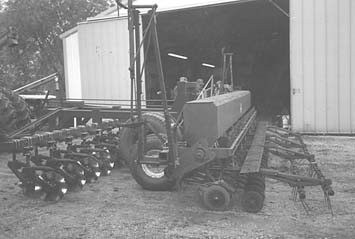
"It lets me plant narrow row, no-till beans with the accuracy of the best row crop planters on the market," says Bob Kepple, Greene, Iowa, who mounted Kinze brush metering units on a rebuilt Tye 20-ft. grain drill that's also equipped with a home-built coulter cart.
Kepple bought the used drill five years ago equipped with 10-in. row units and skip row spacing. The first year he used the drill as it was. The next year he switched to no-till by building a coulter cart from scratch. It consists of a 4-in. sq. 20-ft. toolbar fitted with wavy coulters. The toolbar hangs from a bridge hitch frame made from 4 by 4 and 4 by 6-in. tubing. He also mounted a 2-bar drag (off an old field cultivator) behind the drill. In addition, he replaced the original disc openers with new-style disc openers and added 1 by 10 press wheels and heavier springs.
Two years ago he removed the drill box and made a bigger 60-bu. one, adding Kinze brush meters. The box is built in two sections, each equipped with its own ground-driven shaft. Kepple's cousin helped make a new aluminum housing so the brush meters could be mounted in-line on each shaft.
"It plants much more accurately than the original drill," says Kepple. "I wasn't happy with the original drill because whenever I changed soybean varieties I was never sure how many seeds I was planting. The Kinze brush meters are foolproof. They let me set the drill to plant at exactly the desired population regardless of seed size. If I want four soybeans per foot, that's what I get. I change seed population by changing sprocket sizes at the end of each shaft. The sprockets chain-drive a jackshaft that chain-drives the brush meters. A sprocket that's one tooth bigger or smaller changes the seed population by 10,000 per acre.
"I use a dual wheel semi-truck axle that's operated by a pair of hydraulic cylinders to raise or lower the drill. Another cylinder controls depth of the coulter cart."
